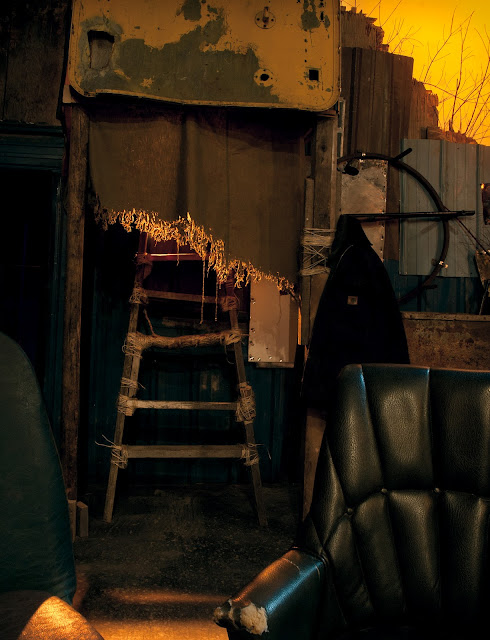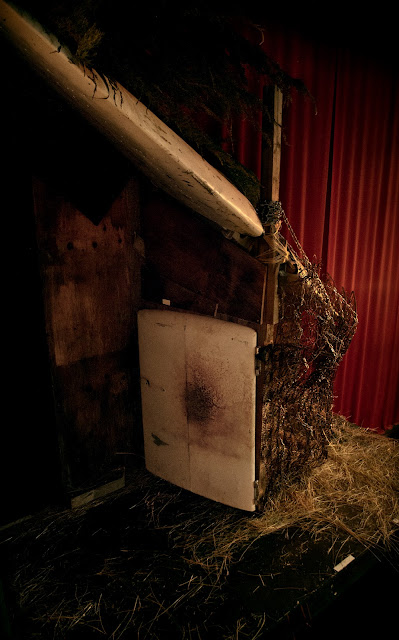In December 2011, writer Josh Wagner
and director Rebecca Schaffer approached me about designing a set for
Josh's post-apocalyptic Christmas play, “Ringing Out.” At first,
I was reserved about joining the production. I was still clarifying
the lessons of the Venn Diagrams/Bee Play and I had a strong sense
that I needed to avoid the flaws of that creative experience in my
next project. When I met with Josh and Rebecca, I expressed three points in particular:
Firstly, that my work designing the set
cannot be isolated from other elements of the production—from the
creative choices made in acting, to costumes, to lighting, to
interpreting the larger thrust of the play. As a set designer I am
to be a collaborator; my ideas and energy multiply, my sense of
dedication is heightened, my natural ebbs of creativity diminish, and
the entire process is more rewarding, revealing when I can
participate in a dialog with others—with the director, the actors,
the writer, the stage manager, a dramaturge. Their vision informs
and modifies my own—gives it flexibility, and resilience, and
electricity. And I feel deeply rewarded when I see those things I am
able to contribute do the same for them.
Secondly, I want to work with people
who understand the set as a fecund and productive element of the
play, equal to the characters in it's power to convey, express,
compel. I am drawn to set design and theatre because it offers an
opportunity to intersect, connect, intertwine, and/or contrast a
visual installation with a narrative. And in the "Ringing Out" production in
particular I wanted convey the narrative richly through my design—through a constellation of details and visual gestures that
each contain micro-narratives (e.g., a book with a worn spine and
dog-eared pages, placed in an easily accessed place; a chair that has
been mended with several different sorts of materials, some brighter
and shinier than others; a battered, door-less refrigerator reused as
a bookshelf; countless jars of rusty nails placed along side
weathered cans of beans; etc). I wanted my set to speak, to reveal
and contradict the characters, to work.
A few concept sketches for the set.
Lastly, designing a well crafted, well
thought out, set that has benefited from a dialog with the other
creators, that pays close attention to it's relationship with the
narrative, takes an enormous amount of time and effort. Physically,
I cannot be the only one constructing it. I need help. I will be
bubbling with ideas and won't have the time or the hands to implement
them. And that is extremely frustrating—perhaps the most
disappointing part of my Venn Diagrams/Bee Play experience.
Josh and Rebecca listened, reassured me
that they shared my goals, I joined on, and we were off.
As I read Josh's play, I was struck by how it worked as a sort of inverted nativity play—turned upside, inside out, mangled, nailed back together from smoldering fragments of an apocalypse. Here are some notes I had on the story-line that informed the set design:
In the original nativity story we all know, Mary is impregnated out of the blue
by God and is told her baby will be the savior of humanity. Shortly
after Mary & Joseph are forced by the Roman government to relocate
to the town in which Joseph was born (Galilee I think) for the census.
On the way there, they're seeking shelter for Jesus' looming birth. No
room at the inn though. So they give birth in an improvised shelter (a
barn) in Bethlehem. Shepherds are there for the birth and a month or
two later three wise Persian kings following a huge, unusual star in the
sky show up to pay tribute to this special baby. All the guests are
welcome; it's a story of gathering, happiness, togetherness, sharing.
In Josh's story, Mandolin (M-name again) is impregnated purposefully, openly as parts of a plan of an elderly couple who has had fertility problems (see also the story of Abraham, Sarah & Hagar), the man of which may have had a perverse scheming to do so since they rescued this very young child in the wreckage. God/Mary/Joseph trio :: Kendra/Mandolin/Rick trio. Again, the child is seen as the savior of their world, but rather than coming into the world to die and cleanse people of their sins, this child is coming to live and procreate—to restore humanity physically rather than spiritually. Mandolin insists the child will be a boy (a knowledge only Mary had of Jesus too; and like Mary, Mandolin has visions, not from the Angel Gabriel but from her own imagination, of what she needs to do). Rather than traveling somewhere at the behest of a larger society, this family is battened down, preserving themselves, because society has ended. The census of this apocalypse is 3. They are not seeking out other people for their help and shelter; they are actively avoiding people, even refusing them their own help and shelter. Again, there is a Persian pilgrim. This time he is not a king wandering purposefully, but a orphan wandering helplessly. No room in the bunker for him. There are no other “pilgrims” or shepherds there; and if there were it would be not to offer gifts and celebration, but to take the trio's supplies and possibly kill them. In this Apocalypse Pageant all guest are unwelcome; it's a story of a unwanted gathering that brings division, turmoil, expulsion. The climax of the story is not the birth of the child, but the birth of the parents, out of the bunker, back into the world.
In Josh's story, Mandolin (M-name again) is impregnated purposefully, openly as parts of a plan of an elderly couple who has had fertility problems (see also the story of Abraham, Sarah & Hagar), the man of which may have had a perverse scheming to do so since they rescued this very young child in the wreckage. God/Mary/Joseph trio :: Kendra/Mandolin/Rick trio. Again, the child is seen as the savior of their world, but rather than coming into the world to die and cleanse people of their sins, this child is coming to live and procreate—to restore humanity physically rather than spiritually. Mandolin insists the child will be a boy (a knowledge only Mary had of Jesus too; and like Mary, Mandolin has visions, not from the Angel Gabriel but from her own imagination, of what she needs to do). Rather than traveling somewhere at the behest of a larger society, this family is battened down, preserving themselves, because society has ended. The census of this apocalypse is 3. They are not seeking out other people for their help and shelter; they are actively avoiding people, even refusing them their own help and shelter. Again, there is a Persian pilgrim. This time he is not a king wandering purposefully, but a orphan wandering helplessly. No room in the bunker for him. There are no other “pilgrims” or shepherds there; and if there were it would be not to offer gifts and celebration, but to take the trio's supplies and possibly kill them. In this Apocalypse Pageant all guest are unwelcome; it's a story of a unwanted gathering that brings division, turmoil, expulsion. The climax of the story is not the birth of the child, but the birth of the parents, out of the bunker, back into the world.
In building the set, I tried to make various gestures to create connections to the nativity play (the chandelier as nativity star, shed as manger, sheepskin carpet as manger sheep, the halo of a gun-rack) but nothing too confining for Josh's work. The story and it's symbols resonates in a lot of other rich ways.
The set took twelve days to build, with the help of the indispensable Diego Fernando Burgos Gomez, our very talented stage manager. The show ran January 17th to 20th at Missoula's Crystal Theater, and then was happily extended for another five shows between the 22nd and 26th. Below are a few pictures and notes
about the set:
An overall shot of the set. It is composed of two sections: (1) The living space of a bunker, which is on the lower stage. That living section is divided into a living room and kitchen. (2) The outside world above, which the actors climb to via a hatch, walk across a thin stage that serves as a path through the woods, and over to a raised platform where the shed sits.
Here is a diagram to convey the layout more clearly.
A couple images to convey how the actors inhabit the two main spaces of the set. One character is being imprisoned in the shed structure which was constructed from an airplane wing, rusted mattress springs, chains, and fragments of wire.
More detailed views of the living space of the bunker. We chose to raise the kitchen on a low platform to improve the lines of sight for the audience. As you can see, actors are often times inhabiting the "kitchen" and "dining room" simultaneously.
Closer shots of the outside world and the "shed" that is used to imprison one of the characters. I needed some way to blend the two sections of the set together smoothly in such a cramped performance space, so I used a material gradient (the hacked up plywood of the wall interior reaching up the branches) hoping to convey a sense that the worlds dissolve into one another. I love how the light from Mandolin's flashlight was caught in the branches.
Before we even began to build the set and the various pieces of furniture, I thought it was important that we inhabit the mind and narrative of the various characters. To construct a wall, a piece of furniture, a decorative or useful object, I had to wonder: which character built this? when was this in their story? what tools or materials might they have at that time? why did they think they need to make this? were they feeling bored, angry, frustrated, sad when they did it? was it more of an emergency fix, was it decorative?
We hobbled together the basic structure of the bunker, stocked it with some simple furniture, shelving, canned goods, survival equipment, as Rick would have done, as if it were years before the collapse of civilization, and we had new or lightly used, human materials at our disposal, things that were partially or fully constructed and could be bought, etc. Other sections and objects we built as if it had been later in their story, after the apocalypse, when human materials would be scarce and mostly salvaged from wreckage, detritus, abandoned structures, things they might have unexpected dug up or stumbled upon and saved. Objects, furniture, repairs to the bunker after the apocalypse, would have to be done ingeniously, unexpectedly—pieced together with a hodgepodge detritus, fragments or disassembled objects, with raw human-made materials like twine, rope, plastic, or tape which Rick would have stocked the bunker, with natural materials, such as branches, stones, grasses they could scrounge up in the surrounding forest. Creating the set was a mixture of archeology and story telling.
A view of the ladder that the characters climb to the get to the outside world. Conceptually and symbolically, this was a very important piece for me. I wanted to ladder to convey a sense of the patriarchal character's neurotic obsessiveness, the haphazardness of their lives in the bunker after the world has "all gone to hell", as well as the sense that these characters have inhabited the space for many years. Symbolically it acts as a sort an axis mundi--their mangled, decaying umbilical chord to a mother earth that died in childbirth many years ago. Woah, did I really just say that? Yeah I did.
At the top of the ladder we placed a locker door that actors could open as they exited to the "outside world." I fashioned it so that the door would make a grating sound as it opens (as two fragments of metal scrap against each other) and a chicken light would cast light down the ladder rungs, as if the eery orange light from the outside world was seeping into the bunker.
These are details from the shed (which conceptually I connected with the manger of the nativity story--in fact I had hoped to design it with a low gable roof, as you can see in the design sketches above, but there wasn't enough room for both sides, so I made one side and hinted that the structure receded into the wall). I wanted to convey a sense that the structure was hobbled together haphazardly to hold their surprise visitor. I used an airplane tail section for the roof, since it references a plane crash that happened on top of the bunker when the characters first arrived. There is also an old fridge door to lock the prisoner in. And I weaved excessive amounts of chain link through the mattress to convey a sense of Rick's (domineering patriarchal character) frantic and hyperbolic character. And I nestled the shed underneath the limbs of a juniper tree, as if the forest were closing in on them, between the lines of the brush branches reaching up and the juniper jutting downward. Another last note: fortuitously, juniper has some very productive biblical symbolism for the play--as a symbol refuge, both for the prophet Elijah from the pursuit of Queen Jezebel's, and apocryphally for the Holy Family as they eluded Herod's soldiers. And then there is the Renaissance symbolism of juniper to represent chastity.[1]
The set was dressed with various props and objects that we identified with each of the three main characters of the bunker. The objects I associated with Rick, strictly practical, often collected from his trips through the woods, and frequently obsessively or haphazardly constructed or repaired. The sentimental or decorative objects I associated primarily with a young, childlike female character, Mandolin. Practical but also decorative objects I associated with Kendra, an older motherly figure.
Note: rusted oil drum where, at one point, the character Rick secures their raggedy Christmas tree.
Note: the jar the red sticks sit in was filled with cast off leaves and water. There jars sit just below the bare brush wall of the forest scene above. I was hoping to create a visual and metaphoric connection between these whimsical, almost morbid decorations that a character like Mandolin might create, and the bare brush branches of the polluted outside world, which the audience could see materializing just above this back wall. Second note: that gun-rack is made from a rusted out trampoline frame. I loved playing with the absurd juxtapositions of a material's original use and it's repurposing.
A detail of some of the provisions that various members of the family have laid out for the kitchen.
Two Vietnam era munitions chests, used for storage & as furniture.
The two key pieces of "living room" furniture that Rick has presumably salvaged, reclaimed, and repaired multiple times with whatever materials he had at hand.
A precarious table, fashioned from brush and scraps wood, for the Glory Horn. An after thought for Rick, who may have built it to please his wife Kendra, but an important piece of domestic furniture for Kendra and Mandolin.
The "chandelier" was another of the whimsical but symbolic set pieces in the play for me. In this case, I saw it as these characters' own version of the Nativity Star—one that flickers and cuts out at different points in the play, serving as a symbol of Rick's illusions of self-salvation.




















































